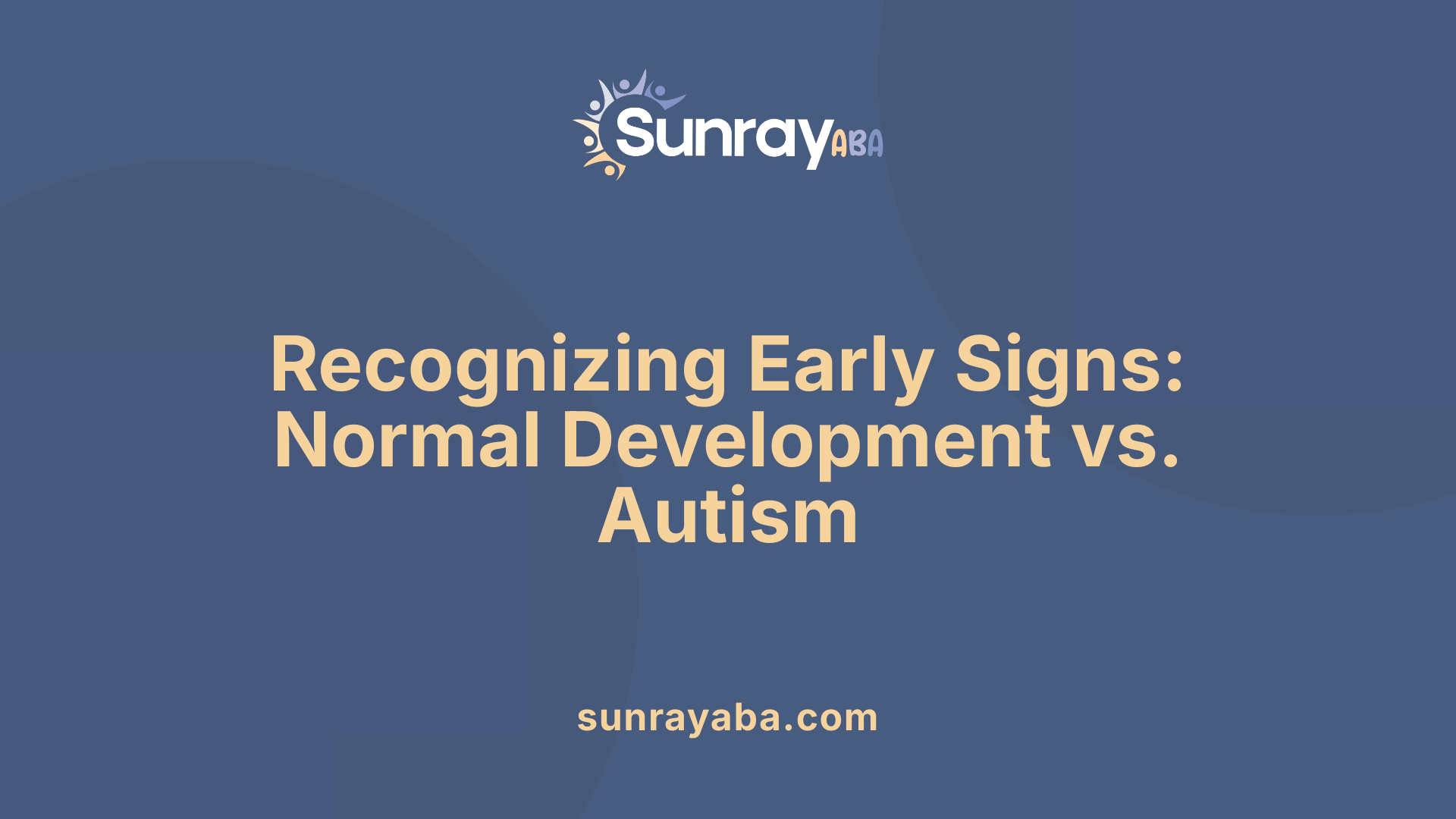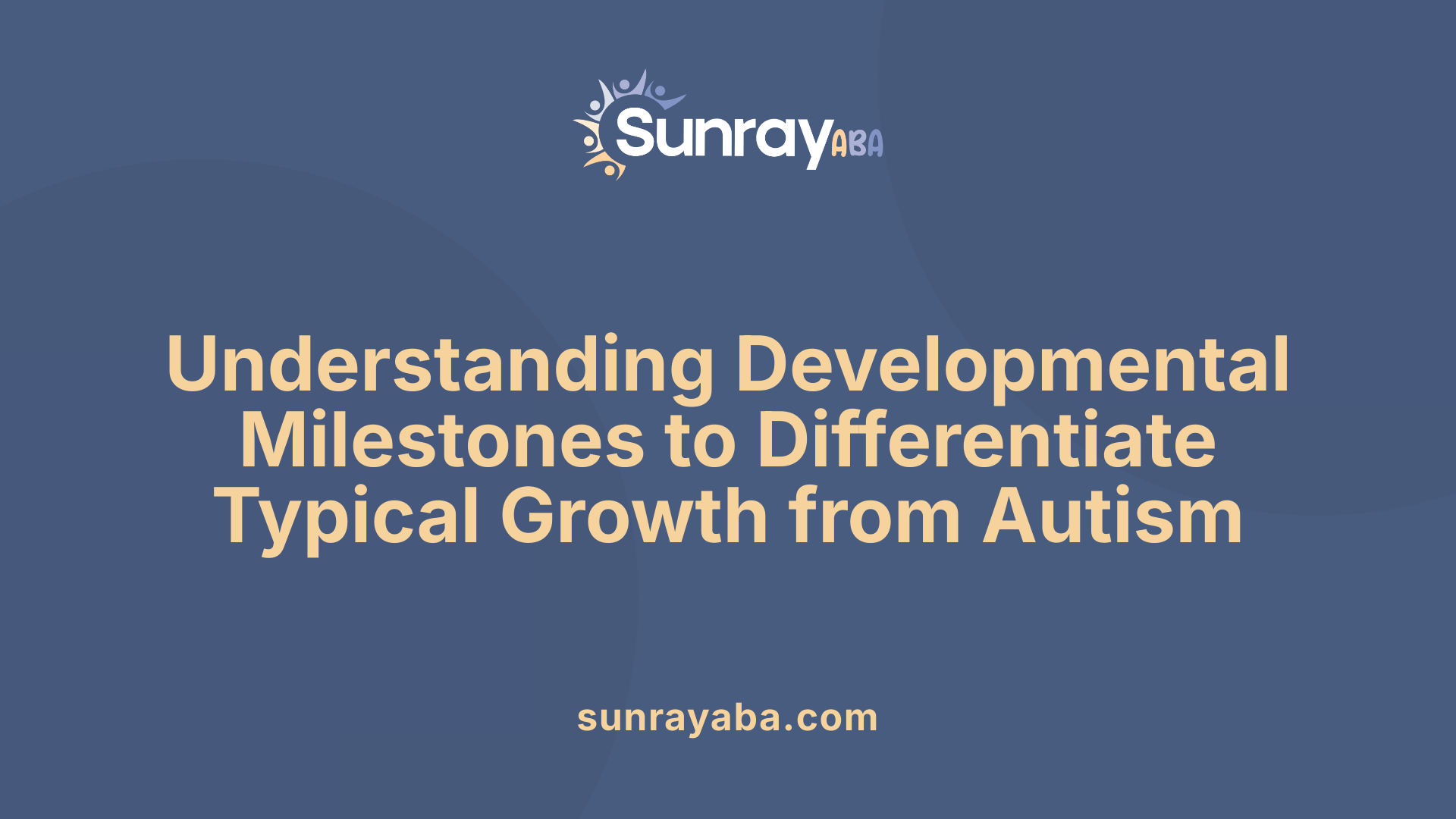Signs Your Toddler Is Not Autistic

Introduction
Recognizing the differences between typical development and signs of autism in toddlers can help parents feel more confident and reassured about their child's growth. While every child is unique and develops at their own pace, understanding standard milestones and behaviors offers valuable insight in early childhood development.
Typical Developmental Milestones in Toddlers
What are the typical developmental milestones in toddlers?
Between the ages of 1 and 3 years, children usually reach a variety of important developmental milestones that mark healthy growth across several areas.
In terms of gross motor skills, most toddlers learn to walk steadily, run, and climb furniture or playground equipment confidently. They often start throwing and kicking balls, which demonstrates increasing coordination and strength.
Fine motor development is equally important. Toddlers typically begin stacking small blocks, grasping crayons or markers to make scribbles, and turning pages of a book. These skills reflect their hand-eye coordination and fine motor control.
Language development progresses rapidly during this period. By 12 months, children often say their first words. As they approach 2 years, many begin combining words into simple two- or three-word phrases. Following simple instructions like “bring the ball” or “wave goodbye” becomes easier, indicating an understanding of language and communication.
Socially, toddlers usually start playing alongside other children—known as parallel play—and may begin sharing toys or showing affection through gestures like hugs. They also imitate behaviors observed in adults, such as pretending to talk on a toy phone.
Cognitive skills are also advancing. Most toddlers recognize basic shapes—circles, squares—and identify primary colors. They can point to body parts when asked and begin engaging in basic problem-solving activities like fitting puzzle pieces or engaging in pretend activities.
Monitoring these milestones allows parents and healthcare providers to confirm that a child's development aligns with typical progress. Early detection of delays in any of these areas can lead to timely support and intervention, promoting better outcomes.
| Developmental Area | Typical Milestone | Age Range | Details |
|---|---|---|---|
| Gross Motor Skills | Walking confidently | 12-18 months | Climbing and running start to emerge |
| Fine Motor Skills | Stacking blocks | 12-24 months | Improved hand coordination |
| Language | Using simple words | 12 months | Phrases by 24 months |
| Social Behaviors | Playing alongside others | 18-24 months | Sharing and mimicking |
| Cognitive Skills | Recognizing shapes/colors | 12-24 months | Engaging in basic problem-solving |
Understanding these developmental landmarks helps guardians support children’s growth and spot early signs of any concerns. Regular check-ups and open communication with pediatricians ensure children stay on track for healthy development.
Differentiating Between Normal Development and Autism

How can I tell if my child's behaviors are normal or indicate autism?
Understanding the difference between typical development and early signs of autism involves careful observation of your child's social, communication, and behavioral patterns.
Signs of typical development include making eye contact from an early age, responding to their name around 6-12 months, babbling by 6 months, and engaging in social play like peek-a-boo by 12 months.
In contrast, early signs that may indicate concern involve fewer social responses and communication attempts. For instance, a child might not smile back during interactions, avoid eye contact, or show limited imitation of sounds and gestures.
It's common for children with autism to demonstrate repetitive behaviors such as stiffening limbs or unusual body movements. They might also show restricted interests or sensory sensitivities.
Recognizing these signs early is crucial. The CDC recommends screening at 18 and 24 months, which helps identify children who need further assessment. If your child's behaviors seem to diverge from typical milestones or if there are persistent concerns, consulting with a healthcare professional is essential.
An early diagnosis can lead to interventions that significantly improve developmental outcomes. Remember, each child develops at their own pace, but being attentive to these signs can provide valuable support when needed.
Social interaction, communication, and play in typical children versus those showing early signs of autism
| Developmental Area | Typical Milestones | Differences in Autism | Additional Notes |
|---|---|---|---|
| Eye Contact | Begins by 2-3 months; consistent by 6 months | Limited or no eye contact from early months | Eye contact typically enhances social bonding |
| Responding to Name | Usually responds by 6-12 months | Often does not respond or respond inconsistently | Indicates social and auditory processing |
| Speech & Babbling | Babbling starts around 6 months; clear words by 12 months | Little to no babbling, delayed or absent speech | Delays can involve both receptive and expressive language |
| Gestures | Waving, pointing by 9-10 months | Lack of gestures like pointing or waving | Gestures help in sharing attention and communication |
| Play Behavior | Imitative and pretend play develops by 12-18 months | Limited play, preferring repetitive behaviors | Play reflects cognitive and social development |
| Social Engagement | Seeks comfort, shows interest in others | Avoids interactions, prefers solitude | Social motivation is crucial for development |
Understanding these differences helps caregivers recognize early warning signs, prompting timely intervention.
Additional helpful resources
For more insights, consider searching “Identifying autism in toddlers” to find comprehensive guidelines and professional advice tailored to your child's age and developmental stage.
Early Signs That a Child Is Not Autistic

What are early signs that a child is not autistic?
Identifying signs that a child is progressing typically can help reassure parents and caregivers. Children who are developing on schedule often display consistent social engagement behaviors. They tend to make eye contact during interactions such as feeding or playing, which usually begins as early as 2-3 months of age.
Furthermore, kids demonstrating typical development respond attractively to social stimuli. For instance, around 6-8 weeks, most infants smile in response to facial expressions or voices, and by 3-4 months, they often laugh during playful interactions. They also follow a predictable pattern of language and play development.
By about 12 months, most children babble and use gestures like pointing or waving, showing understanding of social cues. They usually respond to their name by turning toward the speaker and engage in reciprocal social behaviors like playing simple games or sharing attention.
In addition, children displaying typical growth tend to explore their environment with curiosity, enjoy pretend play, and show interest in other children and caregivers. They may initiate interactions, express a range of emotions, and adapt well to routine changes.
Regular sleep patterns, varied facial expressions, and physical activity like crawling or walking also serve as signs of healthy development. These behaviors, combined, are consistent indicators that a child is following a typical developmental pathway.
Overall, while each child is unique, the presence of these behaviors generally suggests that the child is not on the autism spectrum. However, ongoing observation and consult with healthcare providers remain essential to confirm development is on track.
Reassuring Signs of Normal Growth
What behaviors should I look for to reassure myself that my child is developing normally?
To feel confident about your child's development, observe some typical behaviors that usually emerge at different ages. For instance, responding to their name by turning toward you is an early sign of social engagement that appears around 6 months. By about 6-8 weeks, babies often start to smile socially, known as a social smile, and laugh during playful interactions by 3-4 months.
Engagement in social interactions, such as making eye contact, following objects visually, and reciprocating sounds and facial expressions, also indicate healthy development. Around 9-14 months, children typically demonstrate joint attention behaviors like pointing and following gestures, showing their understanding of shared focus.
In language development, most children will babble around 6 months and use gestures like waving or pointing by 12 months. Words generally start to emerge between 12 to 16 months, with many toddlers combining simple words into phrases by 24 months.
Play behavior offers insight into cognitive development. By 12 months, children often engage in social games like peek-a-boo and start exploring toys creatively through pretend play at 18 months.
Monitoring your child's progress in motor skills is also important. Typical milestones include crawling, standing, and walking by 12-15 months. Delays in these areas may merit attention but can vary among individual children.
Understanding developmental delays
While every child develops at their own pace, certain signs may warrant further evaluation. Challenges such as limited speech, difficulty playing with peers, unusual social withdrawal, or not responding to their name consistently could indicate delays or concerns.
Using developmental milestone checklists from trusted sources like the CDC’s 'Learn the Signs. Act Early.' program can help you track your child's progress. If you notice persistent issues or regressions, consulting your healthcare provider is essential for early assessment and support.
Remember, some behaviors like tantrums or temporary withdrawal are normal at certain ages. However, being attentive and proactive can make a significant difference in supporting your child's growth.
How Milestones Distinguish Typical Development from Autism

How do developmental milestones help differentiate between typical development and autism?
Developmental milestones are essential indicators that help assess whether a child's growth is proceeding normally or if there might be concerns indicative of autism. Most children tend to reach specified benchmarks in motor skills, social interactions, and language in a predictable age range. For instance, typical infants start making eye contact by 2-3 months, smile socially around 6-8 weeks, and begin babbling at approximately 6 months. They usually respond consistently to their names by 9-12 months, imitate sounds and gestures by 9-12 months, and develop basic words by 12 months.
Children on the autism spectrum often show delays or atypical behaviors in these areas. Early signs include limited or no eye contact, a lack of response to their name from 6 to 12 months, and absence of gestures like pointing or waving by 9-10 months. They may also exhibit delayed babbling, fewer social smiles, and limited imitation of sounds or facial expressions.
Monitoring when children reach these milestones provides crucial clues. If a child consistently fails to meet milestones such as joint attention, reciprocal smiling, or use of two-word phrases by 24 months, it may signal autism. Early identification through milestone assessment enables prompt evaluation and intervention, which can significantly enhance long-term developmental outcomes.
While individual differences exist, persistent delays across multiple domains—social, communicative, and motor—are more likely to differentiate autism from typical development. Recognizing these patterns early is vital for accessing support services and fostering positive developmental trajectories.
Supporting Early Detection and Intervention

Why is early detection of autism important?
Early detection of autism plays a vital role in improving a child's developmental trajectory. Recognizing the earliest signs—such as lack of response to their name, limited eye contact, absence of social smiling by 6 months, and delayed speech milestones—can enable parents and healthcare providers to act quickly.
Screening tools like the M-CHAT-R (Modified Checklist for Autism in Toddlers, Revised) are designed to identify children at risk during their toddler years, typically around 18 months. Regular developmental checklists used by pediatricians help in tracking milestones across social, language, and motor domains.
Early diagnosis allows for timely interventions, which are most effective when implemented during the critical early years of brain development. When intervention begins early, children are more likely to develop essential communication and social skills, reduce problematic behaviors, and increase independence.
Consulting healthcare professionals promptly when red flags are noticed ensures that comprehensive assessments can be conducted. These evaluations help distinguish autism from other developmental variations and guide tailored support plans.
Screening tools (M-CHAT-R, developmental checklists)
- M-CHAT-R: A questionnaire filled out by parents to identify behaviors associated with autism.
- Developmental checklists: Standardized tools used during routine checkups to track milestones in social interaction, language, movement, and play.
These tools are accessible and straightforward, providing an essential first step toward early diagnosis.
Importance of consulting healthcare professionals
Healthcare providers, especially pediatricians, are trained to recognize early signs of autism. Regular screenings during well-child visits are recommended at 18 and 24 months.
Consultation with specialists, such as developmental psychologists or pediatric neurologists, may follow if screening results suggest risk. These professionals conduct detailed assessments and confirm diagnoses, initiating crucial early interventions.
Benefits of early intervention
Starting intervention early can significantly improve outcomes for children with autism. Early-supported therapies focus on enhancing communication skills, social behaviors, and adaptive functioning. They can also help reduce the severity of repetitive behaviors and sensory sensitivities.
Children who receive early and intensive support often show progress in language development, social engagement, and play skills. Such progress not only benefits the child's immediate well-being but also sets a foundation for better learning and independence in later life.
| Aspect | Description | Notes |
|---|---|---|
| Screening tools | M-CHAT-R, developmental checklists | First step in early detection |
| Consultation | Pediatricians, specialists | Critical for accurate diagnosis |
| Early intervention | Speech therapy, behavioral therapy, social skills training | Improves long-term outcomes |
| Developmental milestones | Smiling, eye contact, babbling, gestures | Indicators monitored during early years |
Early recognition and appropriate action are essential to support optimal development and ensure children with autism reach their full potential.
Addressing Parental Concerns and Common Misconceptions

How can I be sure my child's behaviors are not signs of autism?
Parents often worry about whether their child's behaviors indicate autism. It's essential to consider the overall development pattern rather than isolated behaviors. For example, many young children go through phases where they might temporarily lack eye contact or show less interest in social interactions. These are often normal variations.
Autism signs tend to be consistent and persistent across various developmental areas. Early indicators in infants, such as not smiling at six months or not responding to their name by 12 months, should be discussed with a healthcare professional.
To confidently differentiate between typical development and potential concerns, consulting with pediatricians or specialists trained in developmental assessment is crucial. They use standardized screening tools and observe multiple behaviors over time.
Understanding behaviors that may mimic autism
Some child behaviors can resemble autism but are actually part of normal growth or other developmental conditions. For instance, a child might seem socially withdrawn during a growth spurt or show temporary speech delays when exploring new interests.
Unusual body movements or repetitive actions can occur in typically developing children, especially during play. Likewise, sensory sensitivities like aversion to certain textures or sounds are common and not exclusively linked to autism.
Atypical but temporary behaviors, such as a short-term regression in speech, might not indicate autism if they are isolated incidents. It’s the duration, frequency, and overall pattern that matter.
Normal variations in child behavior
Children develop at their own pace. Some toddlers might take longer to start speaking or show fewer gestures, and that can be normal if they are otherwise meeting developmental milestones.
Help from early childhood professionals can clarify whether behaviors fall within typical developmental ranges. The presence of a variety of social, communication, and play skills usually indicates healthy growth.
When in doubt, aim for early screening and assessment. This sets the foundation for possible early intervention if needed, which can significantly improve outcomes.
| Developmental Milestone | Typical Age Range | Variations and Notes |
|---|---|---|
| Smiling socially | 6-8 weeks | Some children may smile slightly later |
| Responding to name | 6-9 months | Temporary lapses can occur |
| Babbling in sounds | 6-10 months | Less frequent babbling can be normal |
| Gesturing (waving, pointing) | 9-12 months | Some children may show these gestures earlier or later |
| Using words | Around 12 months | Delays can be temporary |
| Combining words | 18-24 months | Variations do happen |
Being informed and vigilant, coupled with professional guidance, helps parents support their child's healthy development while also identifying any early signs that may need further evaluation.
Final Thoughts
Understanding what typical development looks like in toddlers can reassure parents in their ongoing observations and interactions with their children. While being aware of signs that may warrant concern is helpful, most children develop at their own pace and exhibit a wide range of normal behaviors. Regular pediatric checkups and developmental screenings are essential tools to ensure healthy progress and early identification of any developmental issues, including autism. Early intervention, when needed, can lead to positive outcomes, emphasizing the importance of balanced vigilance and reassurance in parenting.
References
- Autism Signs in Infants
- Signs of autism | Autism Speaks
- 10 Signs Your Baby Is Not Autistic: Indicators to Consider - Affinity ABC
- [PDF] Early Warning Signs of Autism Spectrum Disorder - CDC
- Does My Child Have Autism? - HelpGuide.org
- Signs of Autism in Babies and Toddlers
- Autism signs in children
- Signs Your Toddler Is Not Autistic - Jade ABA Therapy
- CDC's Developmental Milestones
- Developmental Milestones | Children's Hospital of Philadelphia